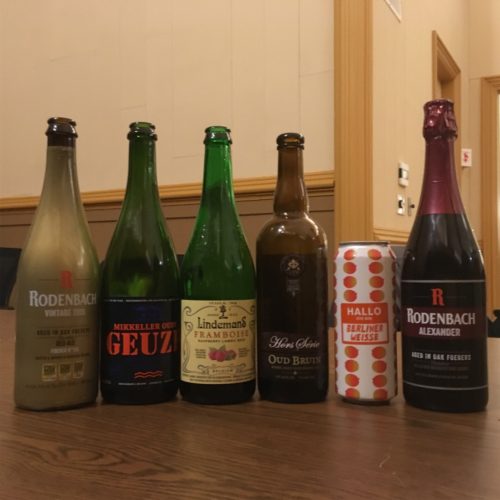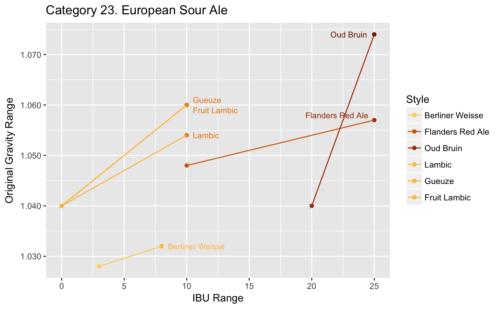BJCP Study Group: Category 23
¶ by Rob FrieselAs of session #21 we have just four 1 categories left to cover. With this session we worked our way through some of the more… interesting beers from the style guide.
I am of course talking about the European Sour Ales.
Category 23. European Sour Ale
It probably goes without saying that for many beer drinkers, this is the least “beer-like” of the categories in the BJCP style guide. All of them are in some way sour (as opposed to malty sweet or hoppy bitter) and many of them are specifically described as “wine-like”. The category description says: (emphasis mine)
This category contains the traditional sour beer styles of Europe that are still produced, many (but not all) with a wheat component. Most have low bitterness, with the sourness of the beer providing the balance that hop bitterness would otherwise contribute. Some are sweetened or flavored, whether at the brewery or upon consumption.
| 23A. Berliner Weisse | 23B. Flanders Red Ale | 23C. Oud Bruin |
|---|---|---|
| 3 – 8 IBU | 10 – 25 IBU | 20 – 25 IBU |
| 1.028 – 1.032 O.G. | 1.048 – 1.057 O.G. | 1.040 – 1.074 O.G. |
| 1.003 – 1.006 F.G. | 1.002 – 1.012 F.G. | 1.008 – 1.012 F.G. |
| 2.8 – 3.8% ABV | 4.6 – 6.5% ABV | 4.0 – 8.0% ABV |
| 23D. Lambic | 23E. Geuze | 23F. Fruit Lambic |
| 0 – 10 IBU | 0 – 10 IBU | 0 – 10 IBU |
| 1.040 – 1.054 O.G. | 1.040 – 1.060 O.G. | 1.040 – 1.060 O.G. |
| 1.001 – 1.010 F.G. | 1.000 – 1.006 F.G. | 1.000 – 1.010 F.G. |
| 5.0 – 6.5% ABV | 5.0 – 8.0% ABV | 5.0 – 7.0% ABV |
While all six of these styles are pretty different from one another, there are a few common elements that unite them. On aroma, all six styles should present as sour (though intensity varies), should convey a fruity impression (again though, intensity varies, and specific fruit impressions vary), and should not convey any significant hop character. For appearance, they… do not really overlap much between all six. With respect to flavor, all of them should be dominated by sourness (though the intensity will vary from style to style, as well as the specific sensory impression) though none of them should ever be vinegary; hop flavors would be inappropriate, as would any significant bitterness (though Oud Bruin can be “restrained” here); as with aroma, fruitiness is common (though intensity varies, as well as the specific fruit impression); all of them should have a “very” dry finish (with Oud Bruin again being the odd-ball here). Similar to appearance, mouthfeel does not have significant overlap between all six. Lastly, with respect to ingredients, all should have a substantial wheat component, use low amounts of aged hops, and while spontaneous fermentation isn’t required it is remarked numerous times as being “traditional”.
While I won’t dig into all the characteristics that differentiate them from one another (whip out your style guide for that), I’ll comment on a couple of notable things. First, appearances vary significantly here: Berliner Weisse being the palest here, the Flanders Red and Oud Bruin having their defining colors right in the name, and the Lambic family being more or less gold (with the fruited variant being essentially any color under the sun). The other thing to keep in mind is the specific sour character of each style: Berliner Weisse should have a clean lactic sourness; Flanders Red should be wine-like and acetic (but not vinegary); Oud Bruin should be “sweet-and-sour” and sherry-like; a Lambic’s sour quality is usually an indicator of the age of the beer, with younger ones being more lactic and older ones balancing out and often taking on a more citrusy sourness (although many drinkers will think of “barnyard funk” here rather than the specific sourness); as a blended Lambic, a Geuze will share many of those same characteristics; similarly, a Fruit Lambic will have those same characteristics, albeit accompanied by the fruit’s contributions.
Before getting into the details of the evening, a huge thanks to the two members that stepped up to purchase the evening’s… course material. Even with our relatively small confirmed group for the session 2 it was — without getting too specific here — “not cheap”. I think I speak for the whole group when I say that we were feeling a lot of gratitude there.
We kicked off the night with a little experiment. One of our members had gotten involved in an online discussion around using electronic scoresheets for judging. The prototype for the electronic scoresheet had been produced using Google Forms and the goal of our experiment was (primarily) to test the conjecture that filling out the scoresheets electronically, while it could get results back to entrants faster, might significantly slow down the judging process. (I’ll spare a write up of the full results here but will say that results were mixed and while faster than I thought, still slower than pencil-and-paper.)
- 23A. Berliner Weisse. A group member’s just-finished-carbonating homebrew. Judged (electronic scoresheet experiment); structured tasting. Scores mostly in the mid-30s. The discussion largely focused on differentiating between a “lemony” sourness vs. lactic sourness, but also how certain other faults might show up in a soured beer. For example, I perceive acetaldehyde to have a “soapy” quality instead of the usually reported “green apple-like aroma”; others did pick up some green apple and/but “tart apple” is an appropriate flavor for the style.
- 23B. Flanders Red Ale. Brouwerij Rodenbach Vintage 2015 (Barrel No. 195). Judged/scored; structured tasting. Scores ranged from 39 to 44, but the majority were clustered at 41. There was a somewhat lengthy discussion around how to differentiate the “acetic” acidic qualities of a beer like this vs. a faulted “vinegary” one. One member suggested that “vinegary” will come through retronasally whereas a more cleanly acidic beer will be almost entirely “in the mouth”. This style also being one of the ones often described as “red wine-line”, we had a digression there about the (strong, in this case) dark fruit characteristics, the layering of those flavors over the not wine-like sour flavors, and finding the malt in a beer like this. In turn, that led to a discussion of how the beer’s aromas and flavor changed as it warmed. Lastly, we did lament (though only slightly) that the bottle hadn’t called out the foeder-aging 3 as this brought too much attention to any oaky and/or tannic qualities that were present. 4
- 23C. Oud Bruin. Les Trois Mousquetaires Oud Bruin. Not scored; casual tasting with scoring estimates. The group’s consensus score seemed to be in the low-to-mid-30s. While it did seem “sherry-like”, it presented to us as less of the expected “sweet-and-sour” and seemed almost too bitter. This is not to say that it was strongly bitter, but more so than the appropriate “restrained” amount. There were also whispers of “enteric” palate (and retronasal) perceptions.
- 23E. Geuze. 5 Mikkeller Oude Geuze. Not scored; casual tasting. Perhaps not surprisingly, for some of our group members, this was the first time that they had sampled a geuze. And perhaps not surprisingly, we almost immediately got into the discussion of what is meant by “barnyard funk” and “horse blanket”. (More on that in a second.) At least one member also queried the group about whether anyone else picked up any light-struck skunk along with the otherwise expected funky character of the beer. (Short answer: “Hard to tell.”) In discussing this beer, we talked through a couple of different aspects. First, we talked through the specifics of the style, with particular emphasis on the spontaneous fermentation and the blending. From there we got into the breakdown of the various sensory characteristics that are discussed in the style guide, speculating on where they might come from and (if we’re being frank) how some people might find beers like this unpleasant. This got us onto a sidebar about participating as a judge in competitions and whether you could opt out of a category like this (short answer: “you can ask”) and how to proceed with judging if you do get a category like this (short answer: “give the best feedback you can while drinking the smallest amount you can manage and lean hard on that style guide”).
- 23F. Fruit Lambic. Brouwerij Lindemans Framboise. Not judged; casual tasting. In a nutshell: “It almost isn’t a fruit lambic.” Given that the style guide provides an ABV range 5.0 – 7.0%, and this one comes in at 2.5% — right there we had some raised eyebrows. Further, as we probed for facts about the beer, we noticed that it is sweetened with non-fermentable Stevia — hence the strongly sweet character that underlies the otherwise very strong raspberry taste. This is not necessarily to suggest that the beer was unenjoyable, but it did not (as far as we could tell) appear to be to-style, and that was less about the ABV being wildly out of the stated range, and more about the fact that this beer presented to every palate in the room as more fruity-sweet than fruity-sour. And after the geuze, it was an interesting study.
Takeaways
- Study the styles that are unfamiliar to you. This was an important study group night that gets at the heart of studying those unfamiliar styles. As noted earlier, multiple members of the study group had simply never had a geuze before and (despite some ahead-of-time reading) were surprised at just how intense its aromas/flavors were. Looking over my notes on the Flanders Red Ale, I was also caught off guard. Even having studied the category’s styles over the past two weeks, I still managed to get “stuck” on a mild astringency that I detected, “blaming” the foeders — but then reviewing the style and seeing that both of those things were probably just fine in the first place.
- Study the judging rules and procedures. I’ve done this (but could use a another refresher) but some members have been focused more on the styles than the judging process. This will be important information to know going forward with judging and getting certified etc. Then again, in the context of the study group, I suppose it depends on whether you’re aiming to get that certification… (Or just hang out and drink some awesome beers.)
- Think about how different faults may (…not) present in strongly flavored beers. Again, this was an interesting study group night because the aromas and flavors in this category are all so strong. Any faults could easily be overwhelmed by perceptions that are supposed to be there. And this is doubly confusing when many of those perceptions are clearly faults in other beers.
- Four? Three? I believe that we intend to cover historical styles but I’m not 100% sure that we will.[↩]
- We had seven show up tonight, as opposed to our usual ten or so.[↩]
- As an aside, trying to figure out the correct way to pronounce foeder was an amusing digression that turned into a running gag throughout the night.[↩]
- In retrospect, we over-indexed on the wood-aged aspect. Looking at the history section in the style guide, aging the beer in a foeder is probably totally appropriate. We can only speculate that the reason it’s called out on the bottle is for marketing purposes alone.[↩]
- As with “foeder”, there was a brief digression where we tried to get his pronunciation correct. I’m not sure that we nailed this one, but at least we made the effort.[↩]


Leave a Reply